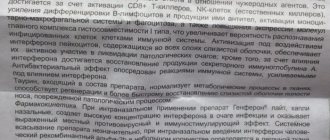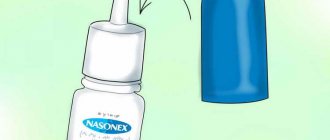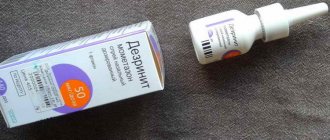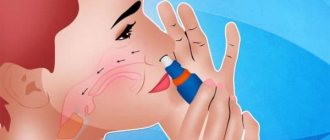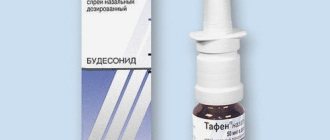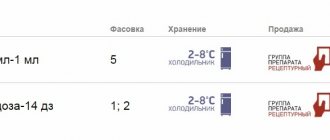Mometasone Sandoz, 50 mcg/dose, 140 doses, metered-dose nasal spray, 18 g, 1 pc.
As with any long-term treatment, patients using Mometasone Sandoz® Nasal Spray for several months or longer should be periodically examined by a doctor for possible changes in the nasal mucosa. It is necessary to monitor patients receiving intranasal corticosteroids for a long time.
Possible development of growth retardation in children. If growth retardation is detected in children, it is necessary to reduce the dose of intranasal corticosteroids to the lowest that allows for effective control of symptoms. In addition, the patient should be referred to a pediatrician for consultation.
If a local fungal infection of the nose or throat develops, it may be necessary to discontinue Mometasone Sandoz® nasal spray therapy and undergo special treatment. Irritation of the nasal and pharyngeal mucosa that persists for a long time may also serve as a reason to discontinue treatment with mometasone.
In placebo-controlled clinical trials in children, when a nasal spray containing mometasone was used at a daily dose of 100 mcg for a year, no growth retardation was observed in children. With long-term treatment with a nasal spray containing mometasone, no signs of suppression of the function of the hypothalamic-pituitary-adrenal axis were observed.
Patients who switch to treatment with Mometasone Sandoz® nasal spray after long-term treatment with systemic GCS require special attention. Withdrawal of systemic corticosteroids in such patients can lead to adrenal insufficiency, the subsequent recovery of which may take up to several months. If signs of adrenal insufficiency appear, systemic corticosteroids should be resumed and other necessary measures taken.
When using intranasal corticosteroids, systemic side effects may develop, especially with long-term use in high doses. The likelihood of developing these effects is much less than with the use of oral corticosteroids.
Systemic side effects may vary in individual patients and depending on the glucocorticosteroid drug used. Potential systemic effects include Cushing's syndrome, characteristic Cushingoid signs, adrenal suppression, growth retardation in children and adolescents, cataracts, glaucoma, and less commonly a number of psychological or behavioral effects including psychomotor hyperactivity, sleep disturbance, anxiety, depression, or aggression (especially in children).
During the transition from treatment with systemic corticosteroids to treatment with Mometasone Sandoz® nasal spray, some patients may experience initial withdrawal symptoms of systemic corticosteroids (for example, joint and/or muscle pain, fatigue and depression), despite a decrease in the severity of symptoms associated with damage to the nasal mucosa. Such patients must be specifically reassured of the advisability of continuing treatment with Mometasone Sandoz® nasal spray.
The transition from systemic to local GCS can also reveal allergic diseases such as allergic conjunctivitis and eczema that already existed but were masked by systemic GCS therapy.
Patients treated with glucocorticosteroids have a potentially reduced immune responsiveness and should be warned of their increased risk of infection if exposed to patients with certain infectious diseases (eg, chickenpox, measles), as well as the need for medical advice if such exposure occurs .
If signs of a significant bacterial infection appear (for example, fever, persistent or sharp pain on one side of the face or toothache, swelling in the orbital or periorbital area), immediate medical consultation is required.
When using a nasal spray containing mometasone, there are no signs of atrophy of the nasal mucosa for 12 months. In addition, mometasone furoate tends to help normalize the histological picture when examining biopsies of the nasal mucosa.
The effectiveness and safety of mometasone have not been studied in the treatment of unilateral polyps, polyps associated with cystic fibrosis, and polyps that completely occlude the nasal cavity. If unilateral polyps of an unusual or irregular shape are detected, especially those that are ulcerated or bleeding, additional medical examination is necessary.
The development of visual disturbances has been reported with the use of both systemic and local corticosteroids. If the patient experiences blurred vision or other visual disturbances, the patient should be referred to an ophthalmologist to determine possible causes, which may include the development of cataracts, glaucoma, or rarer diseases (eg, central serous chorioretinopathy) that have been reported with the use of systemic and topical corticosteroids .
Special precautions when disposing of unused medicinal product
The bottle must be discarded after the specified number of uses or 2 months from the date of first use.
Impact on the ability to drive vehicles and operate machinery
No studies have been conducted to study the effect of the drug on the ability to drive vehicles and operate machinery.
Indications
According to the instructions, mometasone furoate in the form of a cream or ointment effectively relieves itching and inflammation in dermatoses that are treated with glucocorticosteroids: neurodermatitis, stasis dermatitis, solar, radiation, intertriginous and exfoliative dermatitis.
Also, according to the instructions, Mometasone is prescribed to adult patients and children over two years of age for atopic and seborrheic dermatitis, psoriasis, chronic eczema, lichen simplex chronicus, anogenital or senile itching, 1st degree burns, sunburn, insect bites, lichen planus and discoid red lupus.
Mometasone spray is used for the treatment and prevention of nasal polyposis, allergic rhinitis and exacerbations of sinusitis.
Mometasone in the form of a lotion is intended for treating the scalp.
Side effects
External use of Mometasone can lead to local adverse reactions such as burning, itching, skin atrophy and rosacea. In some cases, the drug causes irritation and dryness of the skin, hypertrichosis, folliculitis, hypopigmentation, acne, prickly heat, perioral dermatitis, stretch marks, skin maceration, allergic contact dermatitis or secondary infection.
The likelihood of developing undesirable side reactions increases when occlusive dressings are applied with the drug. If any of the above effects occur, you should stop taking the drug.
Mometasone spray may cause headaches, nosebleeds, pharyngitis, sneezing, nasal irritation, burning in the nose, increased intraocular pressure, or perforation of the nasal septum.
Instructions for use (method and dosage)
Mometasone spray is used for intranasal inhalation. Before performing the first irrigation, 6-7 test presses should be performed (this procedure is recommended to be performed every time there is a break in therapy lasting at least two weeks).
Before irrigation, shake the Mometasone spray can thoroughly. With one press, about 100 mg of suspension containing 50 mcg of active substance is released from the bottle. For treatment and prevention, adult patients and children over 12 years of age are recommended to take 2 inhalations into each nostril once a day. The maximum daily dosage of the drug is 200 mcg.
When a therapeutic effect is achieved, the number of inhalations should be reduced to one irrigation in each nostril. If this does not happen, the dosage of the drug can be increased and up to 4 inhalations into each nostril. According to the instructions for Mometasone, the patient's condition usually improves in the first 12 hours after the procedure.
Children aged 2-11 years are given one inhalation into each nostril once a day. The total single dosage of the drug is 100 mcg.
For exacerbation of sinusitis, patients over 12 years of age are prescribed two inhalations of mometasone furoate twice a day into each nostril. If no improvement is observed, the dosage can be increased to 800 mcg (4 irrigations in each nostril twice a day). When the patient's condition improves, the dosage of the drug should be reduced.
Mometasone in the form of a cream or ointment is applied to the damaged area of the skin once a day. In this case, the duration of the course of treatment is determined individually.
According to the instructions, Mometasone lotion is applied to the scalp once a day, rubbing it in until completely absorbed.
Overdose
Excessive and long-term use of mometasone furoate can lead to suppression of pituitary-adrenal function, which, in turn, provokes the development of secondary adrenal insufficiency. Also, with an overdose of the drug, hypercortisolism (including Cushing's disease) may occur.
When the above phenomena occur, appropriate symptomatic therapy is indicated. If necessary, electrolyte imbalance is corrected. In case of development of chronic toxic effects, gradual withdrawal of the drug is performed.
Analogues of the drug
Almost all medicines have analogues, and Mometasone nasal spray is no exception. Analogue drugs have different names and manufacturers, but the active ingredient is the same.
There are more expensive means, these include:
- Czech "Desrinit";
- American "Asmanex Twisthaler";
- Belgian "Nasonex".
There are also analogue drugs that cost much less, these are:
- "Momat";
- "Gistan";
- "Avecor";
- "Asmanex".
Before you start using them, you should consult your doctor. He will advise the appropriate medicine, taking into account the characteristics of the patient’s health condition, as well as the differences in medications.
Contraindications
Any form of the drug is not prescribed for the treatment of children under two years of age, with hypersensitivity to the active substance of the drug, as well as during pregnancy and lactation.
The instructions for Mometasone also note that the drug cannot be used if the integrity of the skin and mucous membranes is damaged.
Mometasone spray is contraindicated in case of herpes simplex, fungal, bacterial, tuberculosis or viral systemic infection. In addition, this form of the drug should not be used by patients who have recently undergone surgery or trauma to the nose.
Mometasone cream, lotion or ointment should not be applied to the face, as well as to the skin in the groin and axillary areas.
The drug is prescribed with caution during long-term systemic therapy with GCS.
Composition of "Mometasone"
Mometasone spray is a white or almost white suspension. The medicine is a topical glucocorticosteroid. The active substance is mometasone furoate of synthetic origin. Due to its increased concentration, positive dynamics of the disease is ensured.
Excipients are:
- sodium saccharinate;
- carbomers;
- propylene glycol;
- lemon oil;
- pure water;
- trometamol;
- trilon b.
After intranasal use, a small amount of the active substance may enter the gastrointestinal tract. When passing through the liver, it undergoes active metabolism. The drug is excreted in bile and urine.

